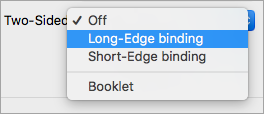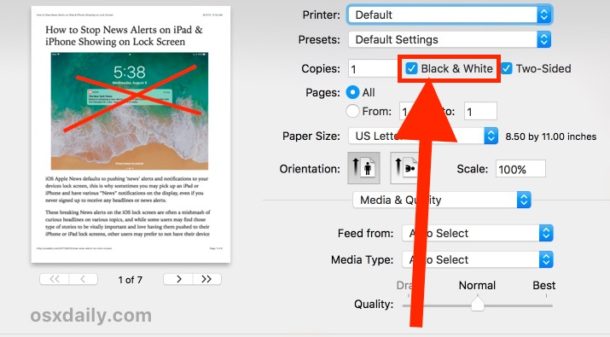

How to Print Double-Sided Documents on Mac. When you want to print single-sided, go to the Presets menu and choose "single-sided" instead. In our experience, that "double-sided" preset will stay selected until you choose something different. When you want to print double-sided, go to the Presets menu and choose "double-sided". You need to click on the dropdown menu and choose “Document” instead.If you want to easily switch between single-sided and double-sided printing, you can create a preset. “Document showing markups” is selected by default. Similar to other Word versions, there’s an option asking you what you would like to print (“Print what”). From there, go to Print, which will take you to the Print dialog. If you prefer dealing with the comments from the main menu, click the Office button located in the top-left corner. 
There’s a dropdown menu that says Show Markup and a Comments checkbox that needs to be turned off. To summarize, you need to find the Review tab, and then the Tracking group from there. Word 2007 also has two methods for preparing a file for printing without any comments, the first one being the same as in the newer Word versions.
After clicking it, you’ll notice that there’s a Print Markup toggle. On the very top is the dropdown menu where you can choose which pages to print. From there, choose Print to open the settings window. 
The other way consists of going to the main File tab.If it’s ticked, clear the Comments checkbox.Now, find the Tracking functions group, and open the Show Markup menu from there.The Reviewing toolbar should appear now, but if it doesn’t, go to the View menu, find Toolbars there, and click on Reviewing. In older versions of Word (20), you should find the Reviewing toolbar and then click Reviewing Pane.

You can choose if you prefer a horizontal or a vertical version.
To show the pane on Word versions 20, you need to enable it in the Review tab, it’s in the Tracking group. The point of the Reviewing Pane is to make reading long comments easier, as well as to provide an overview of all the comments in one place. Additionally, you can do the same thing inside of the Reviewing Pane. The easiest way to delete a comment is by right-clicking on the balloon and clicking Delete Comment. Another way of doing this is to click on the Reviewing Pane located in the Review tab and find the comment you want to change. All you need to do is click the balloon and then change its text. Note: you cannot insert a comment in the document’s header or footer.Ĭhanging comments is very straightforward, as you’ll likely be able to see comments (unless you’ve hidden them). Now, click on the Insert menu, and then choose Comment, a comment balloon will appear again, ready to display whatever you’re about to comment. First, select a word/paragraph, or just click wherever you’d like to comment. Note: Word 2010, 2013, and 2016 are quite similar, so you most likely won’t have any problems if you’re using some of the newer editions. Once you’re done commenting, click anywhere outside of the balloon. Click inside of the balloon and type your comment. If you haven’t selected any text, the word next to the flashing cursor will be selected automatically. A balloon will appear next to the text you selected. It’s located in the Review tab, under the Comments group. To add a comment, select a part of the text the comment refers to and click on the New Comment button. Let’s take a look at how you can insert a comment in a Word document. In Microsoft Word, they are most often used by editors to explain certain decisions or require additional clarifications from the author. What Are Comments and How to Insert Them?īy definition, a comment is a note or annotation that an author or reviewer can add to a document. But first, let us quickly explain what comments are and go through some more basic commenting functions. In this article, we’re going to show you how to pull that off in each version of Word.








 0 kommentar(er)
0 kommentar(er)
